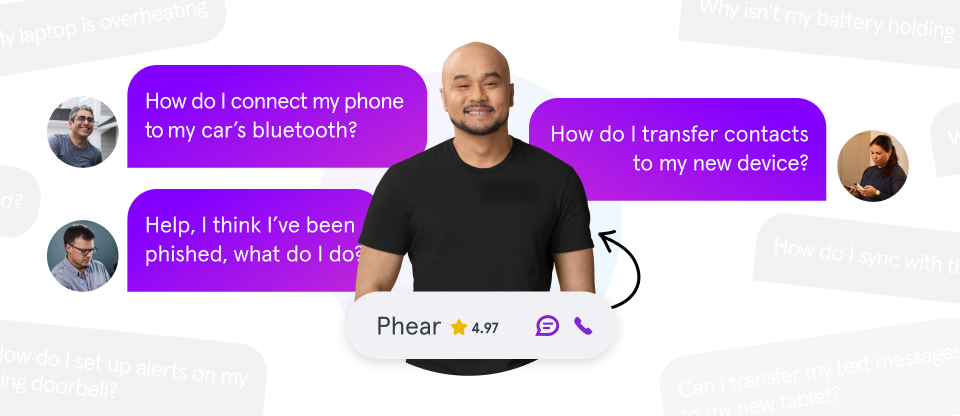Spilling coffee on your laptop during a Zoom® meeting. Dropping your phone on a sidewalk while trying to catch an Uber®. Leaving your tablet just a little too close to the edge of the counter—then hearing that dreaded thunk.
These are all too-common examples of accidental damage, a leading cause of tech breakdowns and unexpected, costly repair bills. Fortunately, there’s a way to protect yourself from those moments. In this guide, we’ll break down what accidental damage really means, what’s usually covered, and which protection plans are worth considering. A reminder that every plan is different and check your plan's specific terms and conditions for what is covered with ADH
What is accidental damage?
Accidental damage refers to physical harm that happens unexpectedly and unintentionally, and that negatively impacts a device’s ability to function. Think of it as damage you didn’t plan for, but that wasn’t caused by a manufacturing flaw either.
Common examples of accidental damage include:
- Dropping your phone and cracking the screen
- Spilling water on your laptop keyboard
- Breaking a smart watch screen when it hits a door frame
These types of accidents typically fall under what's known as ADH coverage (Accidental Damage from Handling). They’re not covered by most standard warranties, which only include issues due to defects or hardware failure.
What’s not accidental damage?
Good question. Most protection plans don’t consider the following to be accidental damage:
- Normal wear and tear (like battery degradation or faded buttons)
- Cosmetic issues (scratches or dents that don’t affect use)
- Intentional damage or misuse
- Natural disasters (floods, fires, earthquakes)
That’s why it’s important to read the fine print in your device insurance or warranty plan.

Don’t waste time scrolling
Life is short. Ask our experts and get answers now.
Common scenarios for tech devices
Phones and tablets
You’re texting while walking and accidentally drop your phone face-down on concrete. The screen’s toast. Or maybe your toddler decides your iPad® makes a great drum.
Laptops
Maybe you’re working from your kitchen table, knock over a glass of water, and—bam—your laptop shorts out. Or the lid gets closed on a charger cord, damaging the screen.
Wearables and gaming consoles
Dropped smartwatches are especially prone to screen cracks, and game controllers can easily suffer internal damage from falls or liquid exposure (snacking and gaming don’t always mix well).
No matter the device, accidental damage protection can make repair or replacement a lot less painful.
Coverage by leading plans
Let’s take a look at what today’s most popular providers offer when it comes to accidental damage:
AppleCare+
- Covers up to two incidents of accidental damage every 12 months
- Applies to iPhones, iPads, Macs, and more
- You’ll pay a service fee ($29–$99, depending on device and issue)
- Screen and back glass repairs are cheaper than full device replacements
Asurion (via major carriers)
- Offers accidental damage protection through carriers like Verizon and AT&T and can cover drops, spills, screen cracks, and even total loss (like theft or loss, depending on plan)
- Claim process is fast—some users get same-day screen repairs
- Also supports wearables, tablets, and even home gadgets
SquareTrade (Allstate)
- Offers ADH coverage plus mechanical failure
- Flexible deductibles and terms
- Available for phones, laptops, TVs, and appliances
- Can be bundled for families or multi-device households
Akko
- Known for affordable, all-in-one device protection
- Covers accidental damage, theft, and internal component failure
- Great for people with multiple devices (e.g., phone + laptop + camera)
- No contracts, monthly plans available
Geek Squad Protection (Best Buy)
- Add-on coverage for devices purchased at Best Buy
- Accidental damage from handling is included with the ADP option
- Covers drops, spills, and power surge damage
- In-store and mail-in repair available
How to choose a plan
There’s no one-size-fits-all plan, so here’s what to consider:
Device types and usage habits
Do you use your phone all day and take it everywhere? Have a clumsy teenager with a gaming console? If your devices are frequently on the move (or in risky hands), ADH coverage is a smart investment.
Cost comparison
Look at both monthly premiums and service fees/deductibles. AppleCare+ has low service fees, but a higher upfront cost. Akko has low monthly payments and wide coverage.
Example:
- AppleCare+: $199 up front + $29 per screen repair
- Asurion: $12–$15/month with a deductible of around $49–$199 per claim
- Akko: $5–$15/month, depending on devices protected
Coverage limits
Some plans limit the number of claims you can make each year. Others have dollar caps on coverage. Make sure you know if your provider offers repairs, replacements, or reimbursement, and how fast they process claims.
Preventive tips
Even with a good plan, no one wants to damage their devices. Here’s how to reduce the risk:
- Use a high-quality case and screen protector. LifeProof and Cellhelmet are top-rated for impact protection.
- Keep liquids away—no drinks near laptops!
- Store devices securely in backpacks with padded compartments.
- Don't charge devices on unstable or cluttered surfaces where they can fall.
Bottom line? Accidents happen. But they don’t have to ruin your tech or your budget. With the right accidental damage protection, a cracked screen or spill is just a hiccup, not a headache. Whether you choose AppleCare+, Asurion, Akko, SquareTrade, or another provider, make sure the plan fits your lifestyle and your devices.
FAQs
Does spilled liquid count as ADH?
Yes. As long as it was unintentional, liquid spills are usually covered under accidental damage protection. Be sure to check your specific plan for exclusions.
How many claims are allowed per plan?
AppleCare+ allows two ADH claims per year. Other providers, like Asurion or Akko, may allow unlimited claims (but often with a cap on total reimbursement).
Warranty vs. accidental damage: What’s covered?
A warranty typically covers manufacturer defects and hardware failures (for a short period of time after purchase). It won’t cover cracked screens or liquid damage. For those, you’ll need ADH coverage through a device insurance or protection plan.
Are waterproof cases worth the investment?
If you’re around water often—say, you hike, have kids, or work outdoors—a waterproof case can definitely help. Just remember: even water-resistant devices can be damaged under the right (or wrong) conditions.
Tried these steps and still need help? We got you. Get your tech problem solved when you call or chat with an expert now.




